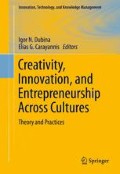Abstract
Any group consists of individuals. Once a person becomes a member of a group, however, his/her creativity will get affected under the influence of the social and cultural environment. This chapter compares and discusses individual and group creativity in China and Japan.
Access this chapter
Tax calculation will be finalised at checkout
Purchases are for personal use only
Notes
- 1.
Now, Nichia is a big company for its sales of 309.7 billion yen and 8400 employees (2013 fiscal year), but it was a small company in 1979.
- 2.
Finally, Shuji Nakamura was awarded the Nobel Prize in Physics with Isamu Akasaki and Hiroshi Amano in October 2014.
References
Amabile, T. M. (1998, September–October). How to kill creativity. Harvard Business Review, pp. 76–87.
Guilford, J. P. (1962). Creativity: its measurement and development. In S. J. Parnes & H. F. Harding (Eds.), A source book for creative thinking. New York: Charles Scribner’s Sons.
Kuroda, T. (2003). Tanaka Kouichi’s life style. Tokyo: Daiwashobo (in Japanese).
Lenovo cultural handbook. (2002). Lenovo Human Resource Department.
Mine, N. (2006). Why Iemon did sold. Tokyo: Subarusya (in Japanese).
NHK. (2002). Project X: Magic noodle. Tokyo: NHK Enterprise.
NHK. (2011). Project X: The first my car in Japan. Tokyo: NHK Enterprise.
Nonaka, I. (1990). Management of knowledge creation. Tokyo: Nihon Keizai Shinbun-sha (in Japanese).
Nonaka, I., & Takeuchi, H. (1995). The knowledge-creating company. New York: Oxford University Press.
Parnes, S.J. and Harding, H.F. (1962). A Source Book for Creative Thinking. New York: Charles Scribner’s Sons.
Stein, M. I. (1974). Stimulating creativity. New York: Academic Press.
Xu, F. (2006). The comparative research between Japanese and Chinese enterprises. Kyoto: Nakanishiya (in Japanese).
Acknowledgments
The author would like to thank Hideki Muneyoshi, the Director of the Institute of Creativity Education in Japan, for his valuable comments.
Author information
Authors and Affiliations
Corresponding author
Editor information
Editors and Affiliations
Rights and permissions
Copyright information
© 2016 Springer New York
About this chapter
Cite this chapter
Xu, F. (2016). Group Creativity and Individual Creativity: A Case Study of the Differences Between Japanese and Chinese Creativity. In: Dubina, I., Carayannis, E. (eds) Creativity, Innovation, and Entrepreneurship Across Cultures. Innovation, Technology, and Knowledge Management. Springer, New York, NY. https://doi.org/10.1007/978-1-4939-3261-0_5
Download citation
DOI: https://doi.org/10.1007/978-1-4939-3261-0_5
Published:
Publisher Name: Springer, New York, NY
Print ISBN: 978-1-4939-3260-3
Online ISBN: 978-1-4939-3261-0
eBook Packages: Business and ManagementBusiness and Management (R0)

